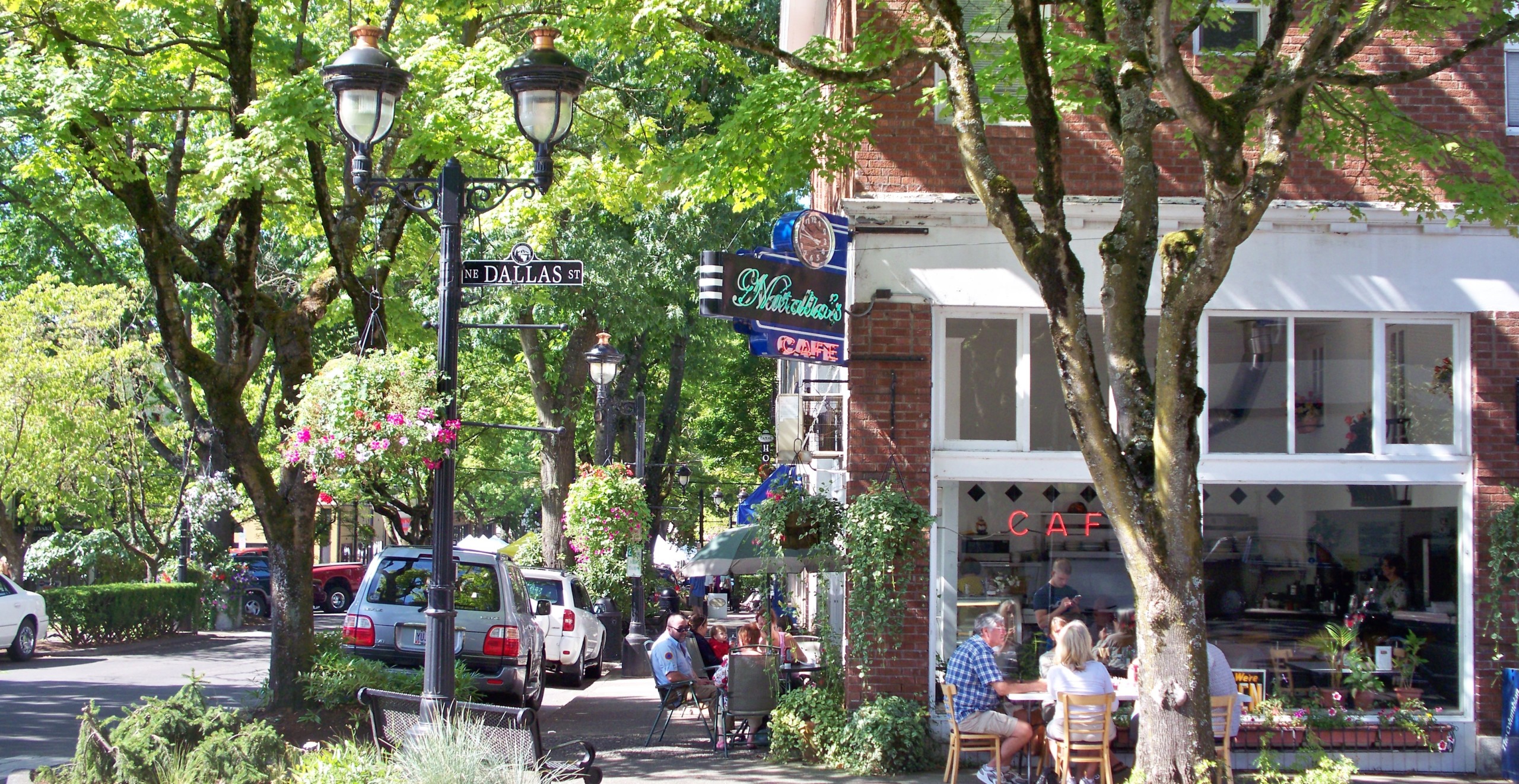Downtown Camas Historic Walking Tour
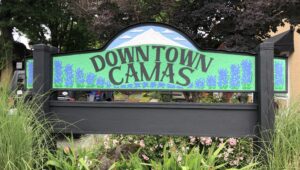
Welcome to the Downtown Camas Historic Walking Tour!
After reading about the mill legacy on the Historic Mill Photo Collage (click here for the narrative), start your tour at the corner of 4th and Adams next to the “Downtown Camas” wooden sign. To get your bearings, the side streets in downtown run alphabetically starting with Adams in front of the Camas Paper Mill.
Look west toward the mill and take a look at what created our town! We love our town and our town’s story. Thank you for letting us share it with you!
In 1883, this area was the perfect place to start a mill. The mighty Columbia River for shipping, nearby lakes to provide power to run machinery and thousands of acres of timber. This was the year that Henry Pittock, owner of the Oregonian newspaper in Portland bought 2,600 acres of land and started building a paper mill to supply better newsprint for his and other newspapers. The mill came first and Camas, originally called Lacamas, grew up around it.
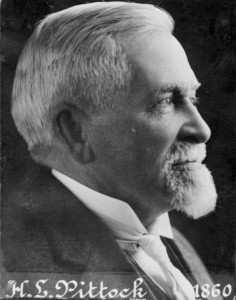
Henry Pittock, 1860
The Columbia River Paper Company was started by Pittock and associates in 1884, and in 1885 the mill started production of newsprint from local timber, straw, rags, and old clothing. Newspaper wasn’t always made of just wood! The original mill was destroyed by fire in 1886, but because it was doing so well was rebuilt in brick and back in full operation by 1888.
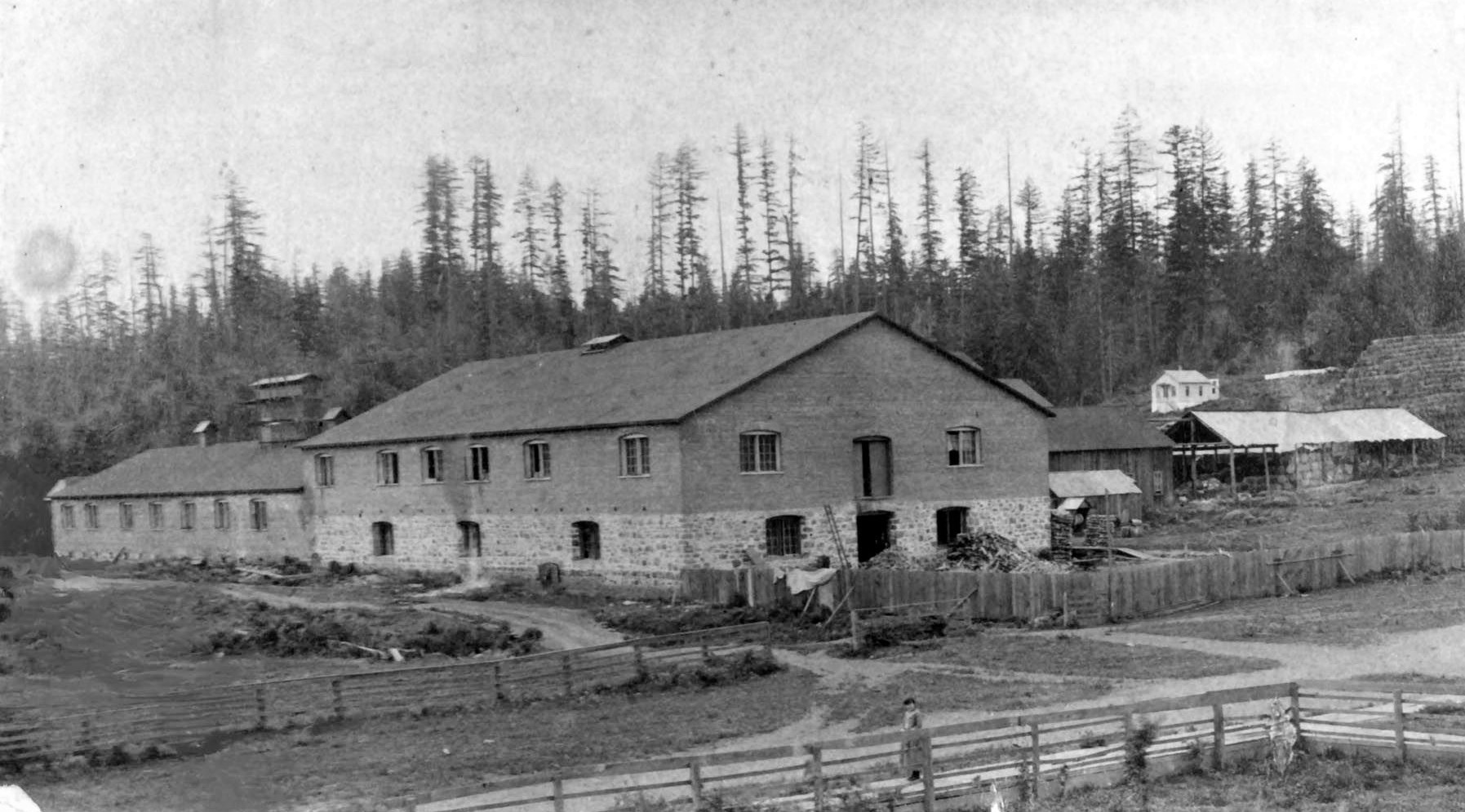
Camas Mill, 1887
The mill started making paper from wood pulp in 1892 and was the first western mill to do this.
The mill produced newsprint until 1930 when it stopped due to cheaper Canadian production. By removing newspaper manufacturing, the mill was able to become the largest specialty mill in the world. Right here in little Camas!
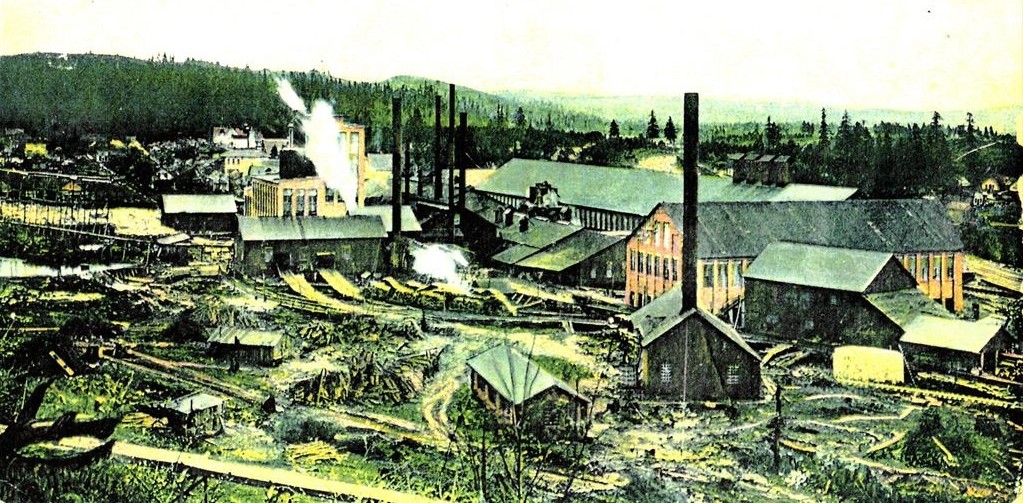
Camas Mill, 1910
The mill has gone though many ownership changes over the years. Click here for the Camas Mill Timeline.
The mill came first and then all the shops and businesses to support the people that worked at the mill and their families were built over time to create the downtown. By the late 20’s, it was a thriving town full of shops, restaurants, healthcare, banks, theatre, hotels, barber shops, car dealership, opera house and more. The mill took good care of the town and even during the Great Depression, no mill worker was laid off. All workers were given enough hours to keep bread and milk on the table.
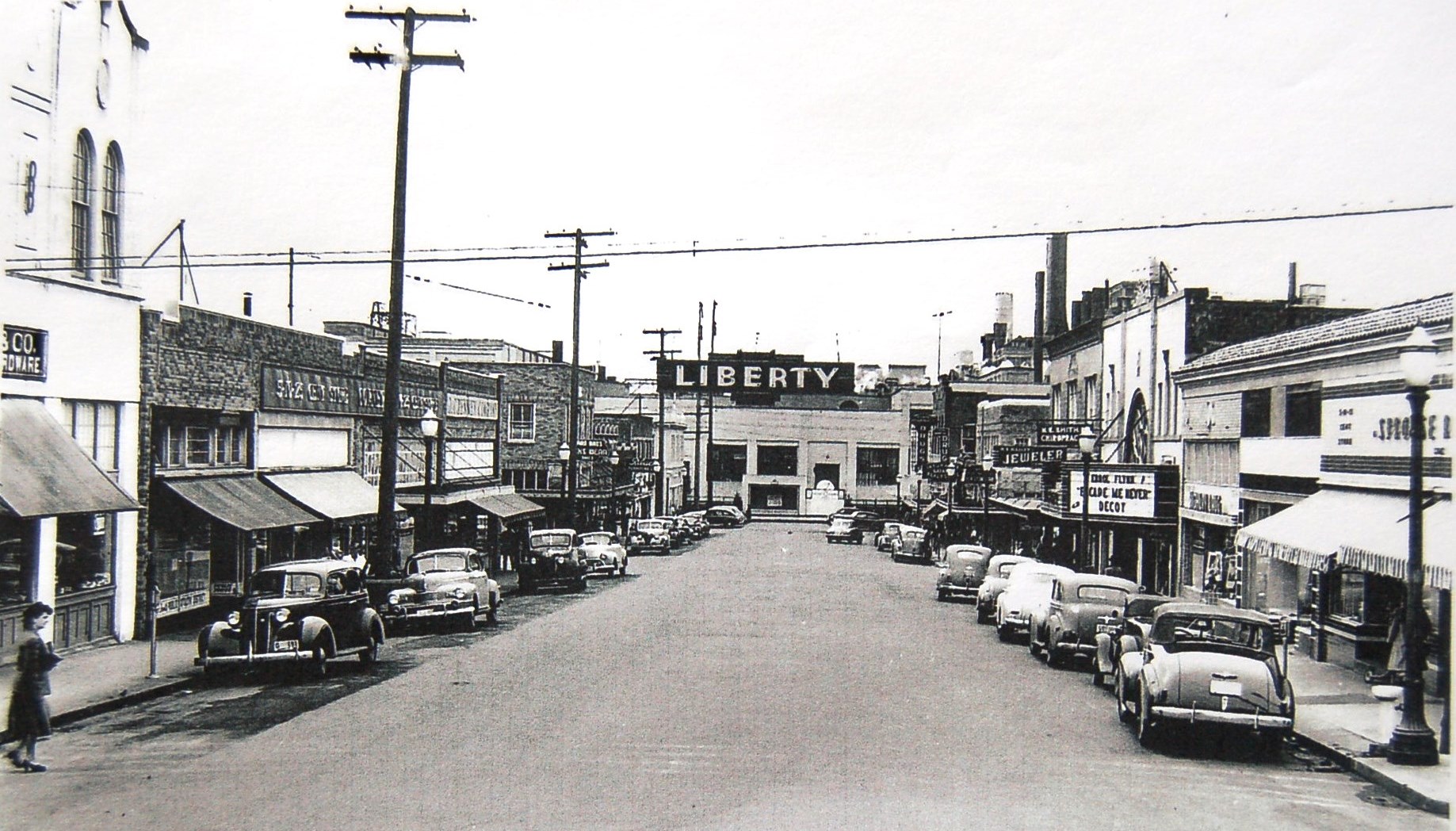
4th Avenue facing the mill, 1947
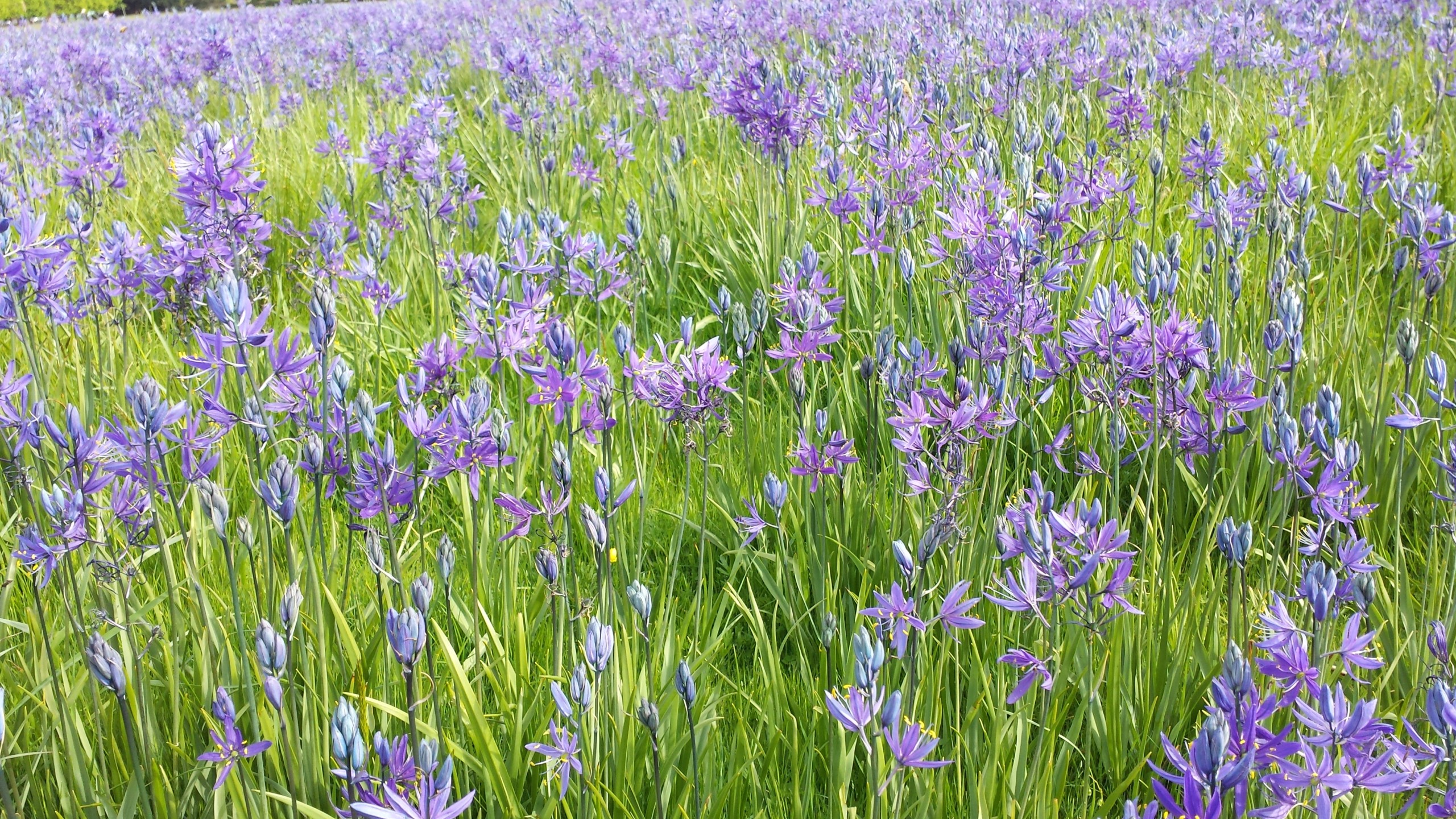 Notice the purple flowers on the Downtown Camas sign? These represent Camas lilies, our namesake! Camas lilies grew abundantly here and were a main food staple for the Southwest Washington Native American People of the region, allowing tribes to survive harsh winters. We appreciate that our town was named after something both beautiful and a symbol of sustainability and strength. You can still find meadows of Camas lilies blooming each spring in the hills of LaCamas Park.
Notice the purple flowers on the Downtown Camas sign? These represent Camas lilies, our namesake! Camas lilies grew abundantly here and were a main food staple for the Southwest Washington Native American People of the region, allowing tribes to survive harsh winters. We appreciate that our town was named after something both beautiful and a symbol of sustainability and strength. You can still find meadows of Camas lilies blooming each spring in the hills of LaCamas Park.
Take a minute to look up 4th Avenue. Our downtown looks the way it does thanks to a number of factors–In 1923, there was an extensive fire in downtown and 3 city blocks burned, which at that time was most of the downtown! Wooden buildings were rebuilt in brick, a reason we have many of our historic buildings still intact today.
4th Avenue has a beautiful tree canopy and charming aesthetic. These large trees were planted in 1967 as part of a downtown revitalization plan called Operation 4-Sight that also included wider sidewalks, flowers, benches, store awnings, outdoor telephones, outdoor sound system, gazebos, and buried electrical and phone wires. This was very progressive for the time. These innovative efforts created a more pedestrian friendly town and set the stage for the downtown experience we have today!

Downtown Camas 1967 looking east
To read from the original Operation 4-Sight documents, click here.
Now let’s head up 4th Ave, our Main Street!
As you walk past the Camas Barber Shop on the right, look to the left and find an historic interpretive panel that tells more about our town history.
As you continue up 4th, look in the landscape bed to the left and see if you can find the bronze owl looking at you. It is part of the Hidden Bronze Bird Tour—14 bronze birds nestled throughout Downtown Camas for you to find! 13 of these bronze art pieces were created by Washington artist Georgia Gerber, the same artist who created the bronze animals around the Pioneer courthouse in downtown Portland and Rachel the Piggy Bank at Pike Place Market in Seattle. These lovely birds, all native to our region, were installed in Downtown Camas in 2017. There is also a lovely bronze goose in the library courtyard made by famed Camas artist Mike Smith.
Walk a bit further past our gourmet Mexican restaurant Nuestra Mesa on the right (here since 2010–best house made chips and guacamole ever!) and stand at the corner of 4th and Birch.
Across 4th Avenue on the corner with the striped awning is Lily Atelier, a fine women’s clothing shop which has been a staple in our town since 2003. The building was built in 1929 by Robert Stoller who was a key figure in developing downtown in the 1920’s. This building has a heavy art deco influence typical of the 20’s and 30’s with terra cotta tiles and accents along with a belt of brick in a herringbone pattern above the second story windows. Hunter’s Hardware occupied this space for many years.
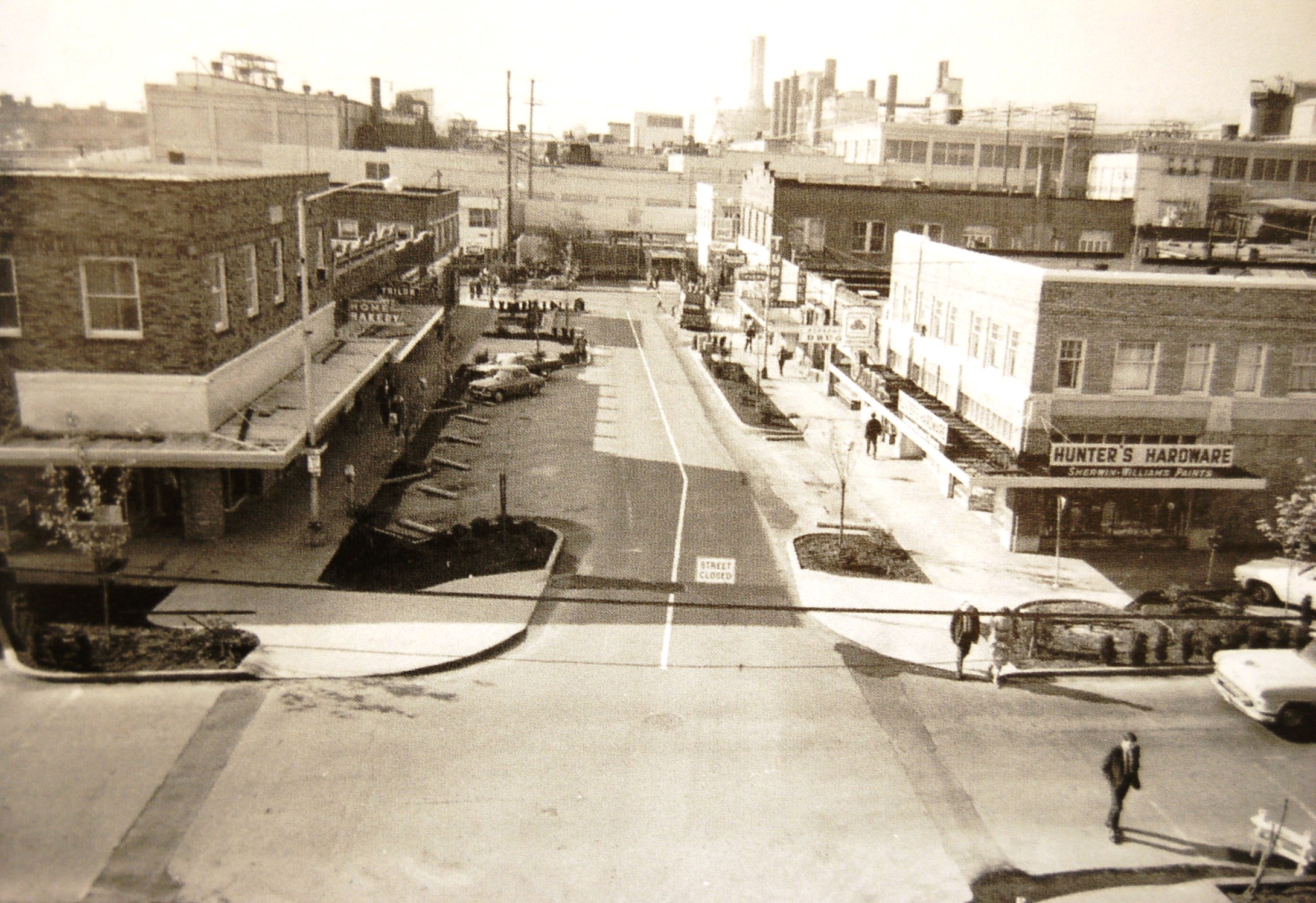
4th Avenue facing the mill with Hunter’s Hardware on the right, 1967
Shift your eyes to the right to the stunning Farrell Building where Camas Antiques has been a thriving business since 2004. The building was completely remodeled before they moved in including 8 apartments above and a full basement with many more antique vendors downstairs. This building was built in 1924 by Charlie and Rose Farrell and was designed by John Roffler, Rose’s brother and a prominent builder in early Camas. You can see his trademark “Roffler Rock” work in the building above the awnings. JC Penney was the first store here before it moved across the street. The store Farrell and Eddy’s was operated by the family for 53 years (Rose was in her 80’s!) from 1945 until they closed the doors forever in 1998. For more information about the prominent Farrell Family and this historic building, click here.

Farrell Building and Granada Theatre, early 1930’s
The building across the street from Camas Antiques where Journey Church is now was also built by Robert Stoller in 1935. The site had been the original wooden Camas Hotel before it was torn down to build this polychrome brick building. This building housed J.C. Penney from 1935 until the 80’s when Penney’s moved to the mall. Various bars were in this location after that allowing the building to go into disrepair. Journey Church bought the building, completely renovated it down to the studs and old growth beams and moved in in 2009. When you’re across the street in front of Camas Antiques and the sun is just right, you can still see the faint outline of the J.C. Penney letters above the windows on the front of the building.
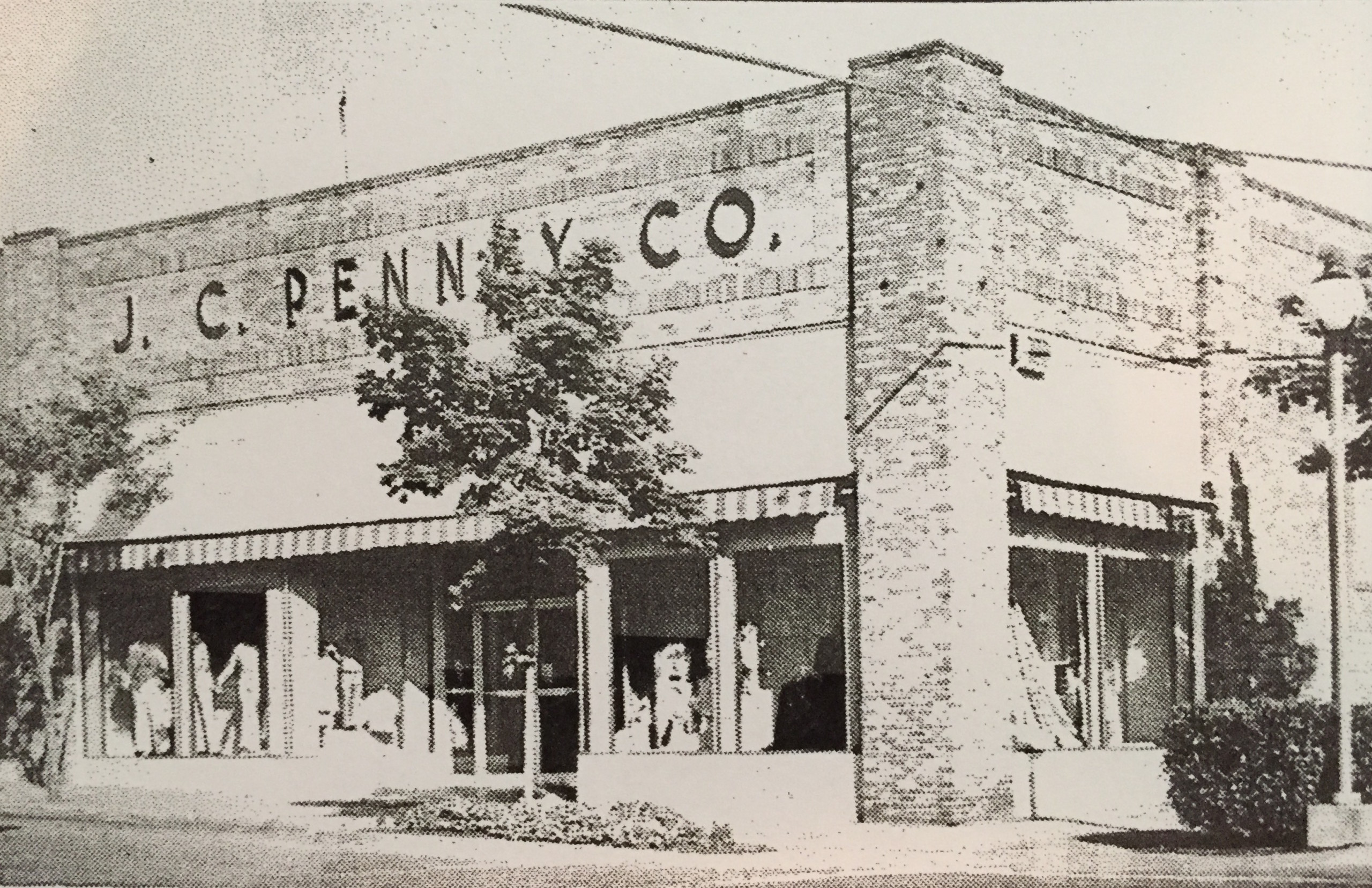
J.C. Penney, 1976
Walk up to mid-block and look across the street to the glorious Liberty Theatre, originally the Granada Theatre built in 1927. One of our most iconic and picturesque locations in all of Camas! It was built by Charlie Farrell and other investors for $75,000 which was a lot of money back then! It was grand in all respects. It opened when movies were still silent so there was an organ that played music to set the scenes! Under new ownership, it was renamed the Liberty Theatre in 1938. Fire gutted the theatre in 1994 but the Farrell family, who still owns it today, completely refurbished it, maintaining its historic 1920’s feel. It still feels that way today! For more information about this historic theatre, click here.
As you continue walking, you’ll find another historic interpretive panel on the left that tells you more about our iconic historic buildings.
Keep on walking up 4th Avenue to Cedar Street.
The building at your right (where Camas Slices is now) was built in 1922. Town leader and former mayor, Wilmer Swank operated his furniture business here and the IOOF (Odd Fellow’s Hall) was upstairs. People came from miles around to shop at this quality store, very large for this area. Crown Appliance took over operations in 1958 and added furniture in 1969. The Fisher family bought the business in 1978 and operated Crown Home Furnishings until July 4th, 1993 when a fire, started by fireworks, swept through the building. It was restored without the second story and Crest Realty (Windermere) was here for 10 years before moving to their location on 3rd and Cedar (Fun Fact: Crest Windermere is still owned by the Stoller Family of early Camas!). This building was later remodeled by Mill City Brew Werks including excavating the basement for their beer production and opened to the town’s delight in 2013, becoming the town’s very first brewery. Camas Brewing Company now occupies this brewery space.
(Another Fun Fact: W. Swank started his furniture business in 1906 (in a previous building) and in 1912 took over a local funeral business as well! Busy man! He moved Swank Funeral Home to 3rd & Cedar in 1915 and a new chapel was built in 1932 designed by John Roffler. It became Straub Funeral Home in 1953 and Jyl Straub, who lived above the funeral home as a little girl, still owns The Wild Hair salon – also on Cedar Street – which has been downtown – since 1990!)
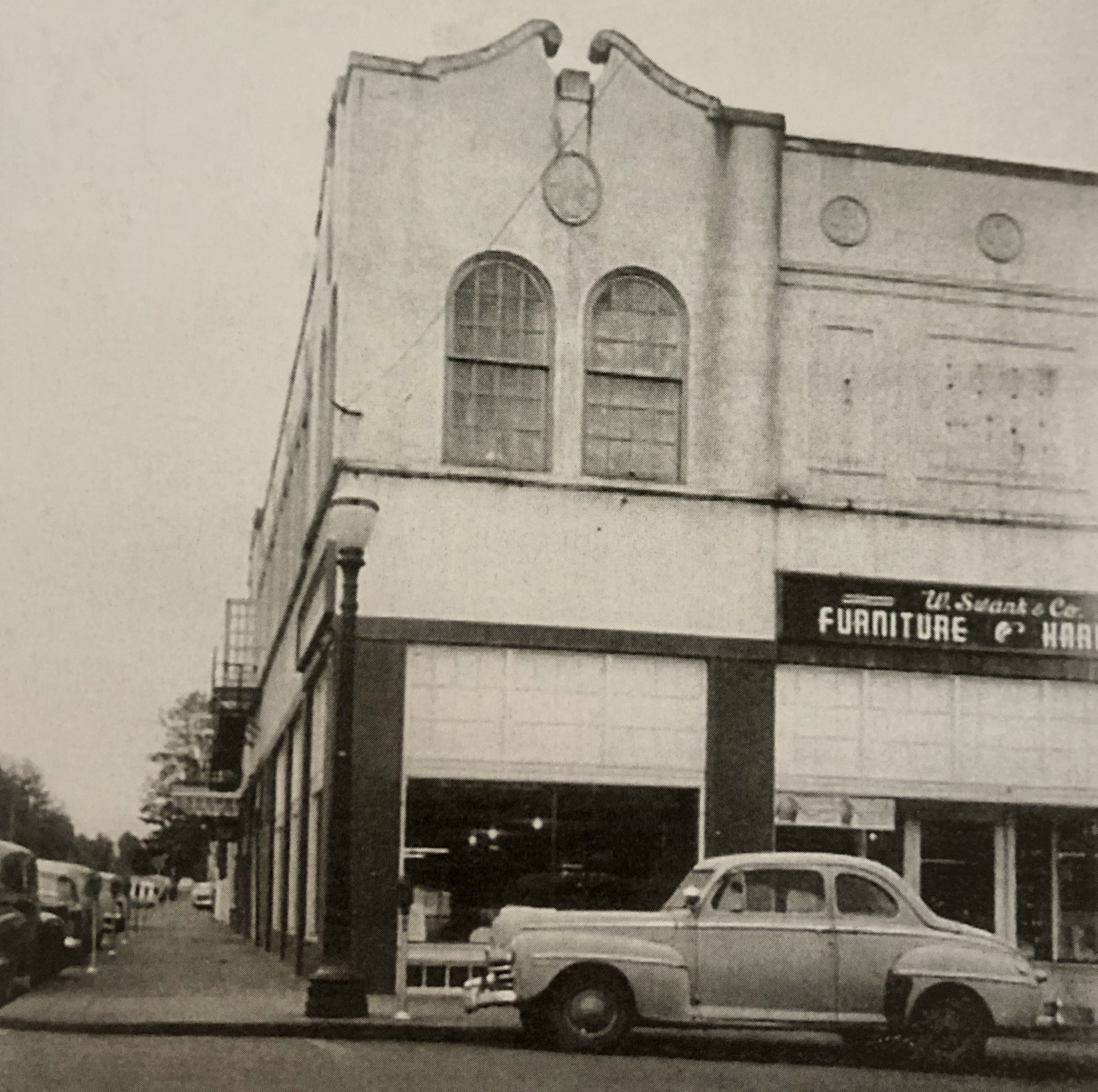
Swank Furniture and IOOF upstairs, 1948
Across 4th Ave, you’ll see a corner fountain, in honor of 911. The plaque says In Memory of September 11, 2001, The Day That Changed Our Lives. You’ll notice one of the hidden bronze bird art pieces by it—a whimsical duck trio. The owners of the Feast 316 restaurant in downtown sponsored the ducks in honor of their three children. To the left you will see our iconic Little Bronze Girl sitting on the bench and reading her book. She has graced our town since 2002 and has had about a million pictures taken with her!
The building on the corner by the fountain was built by O.F Johnson who built Camas State Bank at this location in 1908, the very first bank building in Camas. That original bank building burned down during the 1923 downtown fire. The new building was built in 1925 and was first a clothing store and then a Sprouse Reitz store from 1932 until 1993—61 years! Many people have fond memories of that five and dime store, especially buying candy and small toys there when they were children! The building was fully remodeled in 2004 including a full basement of offices and you can also see a Camas streetscape mural (2005) painted in the entry on Cedar.
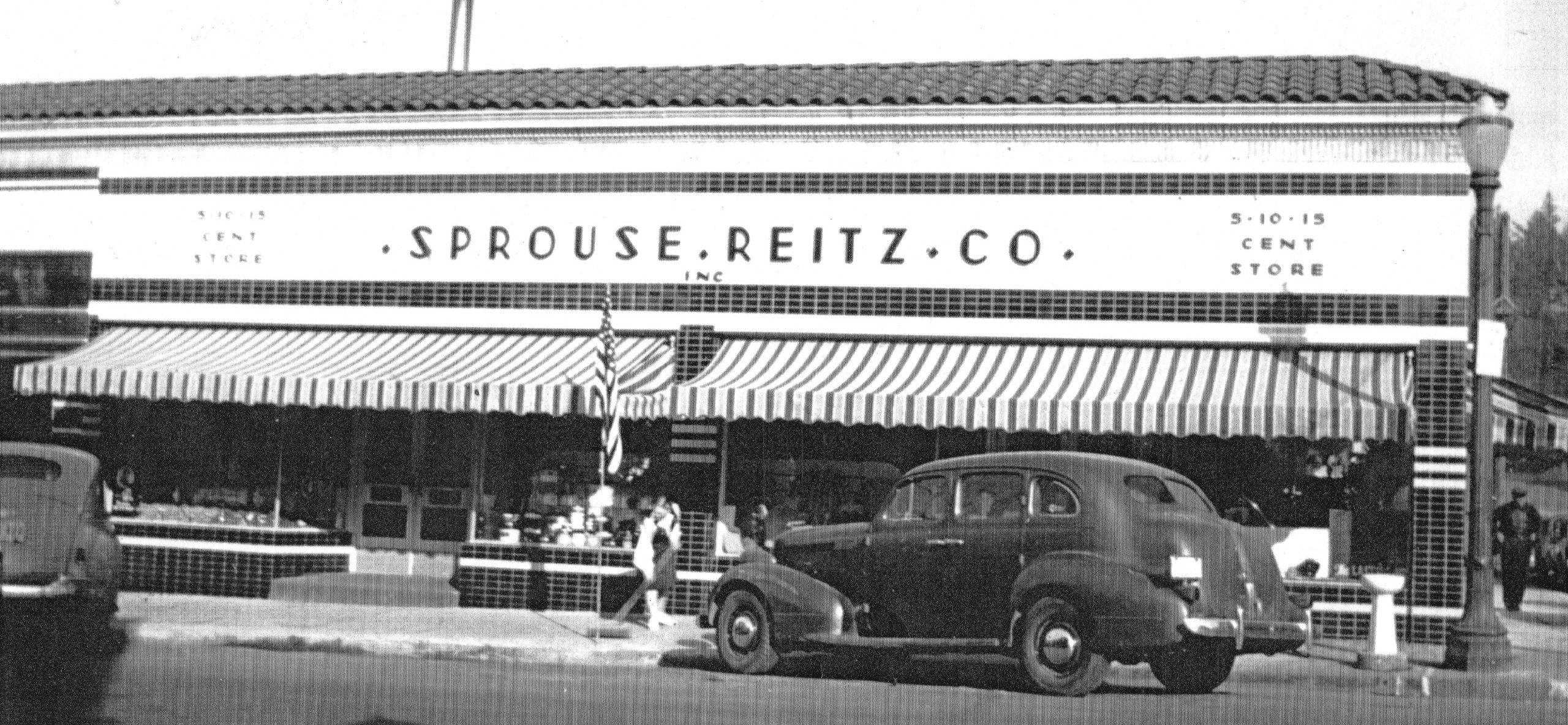
Sprouse Reitz, c.1939
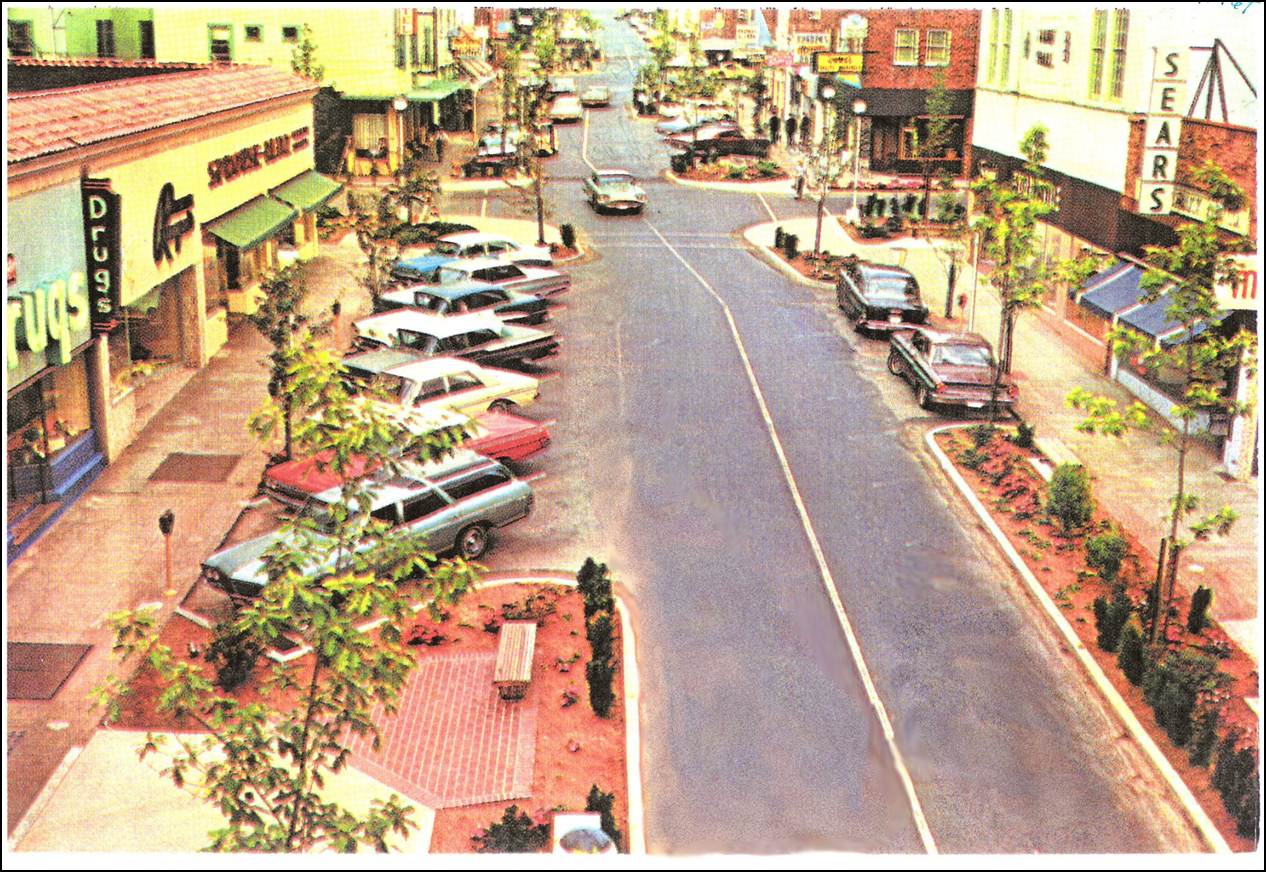
4th Avenue looking east 1967 with Sprouse Reitz at top left
A few doors down is Runyan’s Jewelers—they have been a family owned business in our downtown since 1946! 3 generations for over 70 years. They also do clock repair and you can see the clock they added to the lamppost in 2001 out front. They have been true to their quality products and customer service, hence their longevity in our town.
Looking across the intersection of 4th and Cedar, you will see the Camas Hotel, the oldest commercial building in Downtown Camas, built in 1911. It survived the town wide fire of 1923 and was remodeled in 2009 to the beautiful hotel it is today. It was built by Paul Hinz and was originally called the Commercial Hotel, changing its name to the Camas Hotel when the original Camas Hotel (where Journey Church is now) was torn down. It is now a European style luxury hotel and a strong tourism driver in our town. You’ll notice on the right side of the building a large mural of Camas lilies painted by local artist Anna Norris.

Early Camas Hotel
Continue walking up 4th and notice the gorgeous historic Camas mural above Camas Gallery. It was painted by Italian fresco artist Maria Grazia Repetto and installed in 2013. Notice all the details that show what our town looked like in the early 1900’s. Prints of this mural are available in Camas Gallery!
Keep walking up to the next intersection of 4th and Dallas.
Across 4th Avenue you will see Natalia’s Café. Can you believe that in 1922 this was the edge of town? Just trees beyond. This building was built in 1930 and housed the Ideal Bakery. By 1938 it baked 6000 loaves of bread a day to be delivered to Camas homes and the surrounding area (Camas had a population of just over 4,000 at the time!). It later became the Ideal Corner Cafe, a beloved diner that was here for many, many years. It was sold and became Natalia’s Café in 2003 and has been under new ownership since 2015. The new owners have taken this diner to new heights with hearty food, open grill cooking and friendly small town service. (They are known for sharing bacon with any dog that comes to their door :))
Across the street we have the Lutz Hardware building which was originally two buildings. 1n 1932, Fred Stoller (Robert Stoller’s nephew) had an elegantly designed chapel built at this location called Stoller’s Memorial Chapel and on the corner he built a new furniture store called Camas Furniture. The two buildings were later remodeled to make one building. It was bought by the Lutz family in 1989 for their Coast to Coast hardware business which they had started in 1950. It’s now Lutz Hardware and it is wonderful to still have a family owned hardware store in our downtown! On the corner of the building on 4th and Dallas you will see paintings of 3 cats by artist Anna Norris—Coaster, Socket and Dallas, all cats that have welcomed customers into Lutz Hardware over the many years!
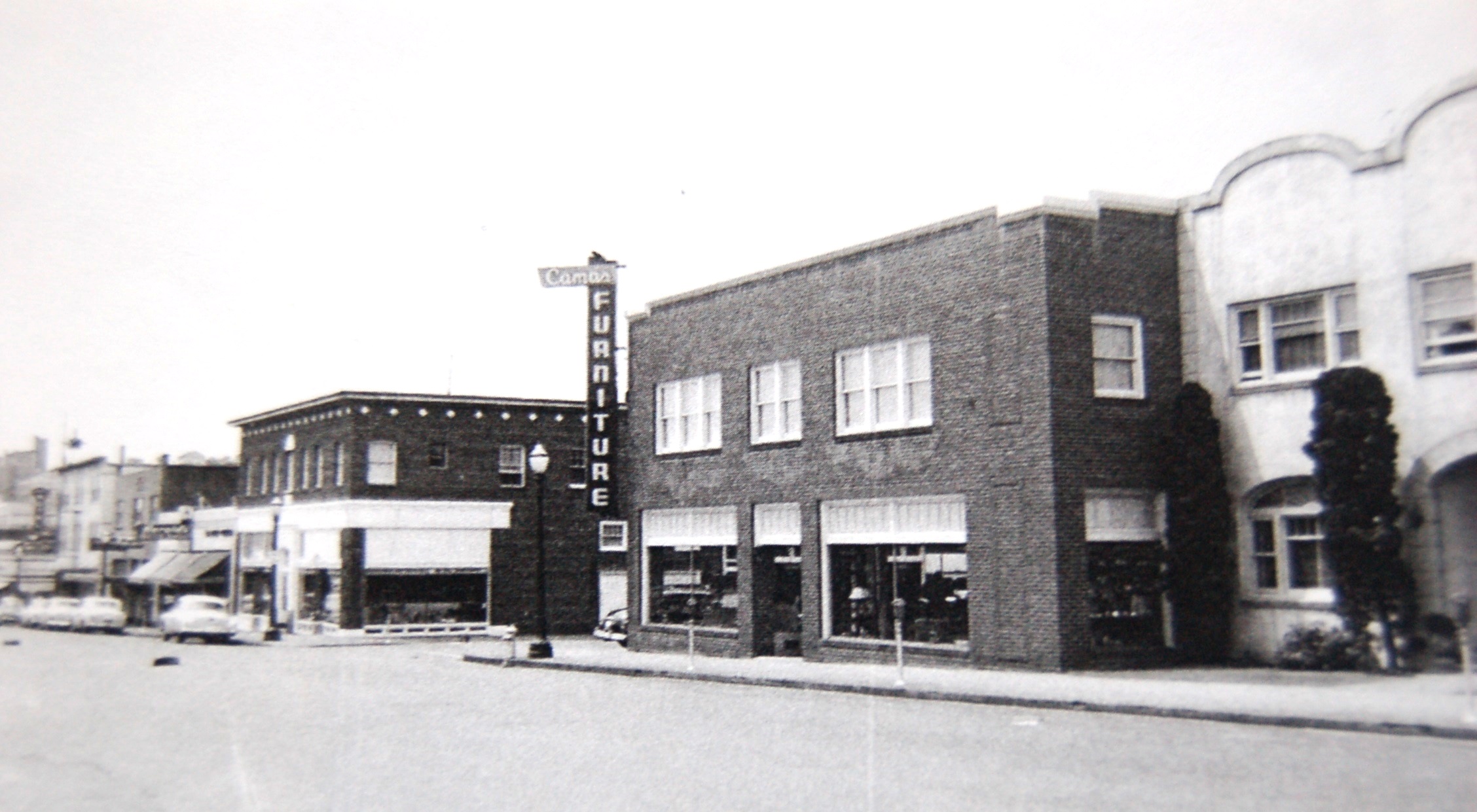
Camas Furniture and Stoller Memorial Chapel (white building) where Lutz Hardware building now stands. Natalia’s Café building in the background.
Walk up one more block to 4th and Everett and you’ll find another historic interpretive panel that tells the story of legendary people that have made a difference in Camas history.
Across the street you will see the majestic Camas Public Library. The east side of the library was built in 1940 and housed City Hall, the police department/jail, the library and the fire department! The fire trucks would exit the building on Franklin Street. In 1967, City Hall and the Fire Department moved across the street into the building they are in today. In 2003, the western portion of the library was built to match the styling of the original building. The original building was built by D. W. Hilborn, an extremely talented and respected architect in our area, also designing the Kiggins Theater and Clark County Courthouse in Vancouver, the Lily Atelier Stoller building on 4th and Birch and the Adeline building on 5th and Cedar where Camas Bike & Sport is. For more library history, click here.
(Fun Fact: You’ll notice a Camas street emblem in the intersection. It was designed by a Camas High School student Brianna Cloutier as part of an art contest put on by the Downtown Camas Association (DCA) and was first painted by art students and the DCA in 2016. It is repainted each year, along with its twin in the next intersection, before the Camas Farmer’s Market–which is held at this location and was the inspiration for the emblems–begins in June.)

Original City Hall built in 1940
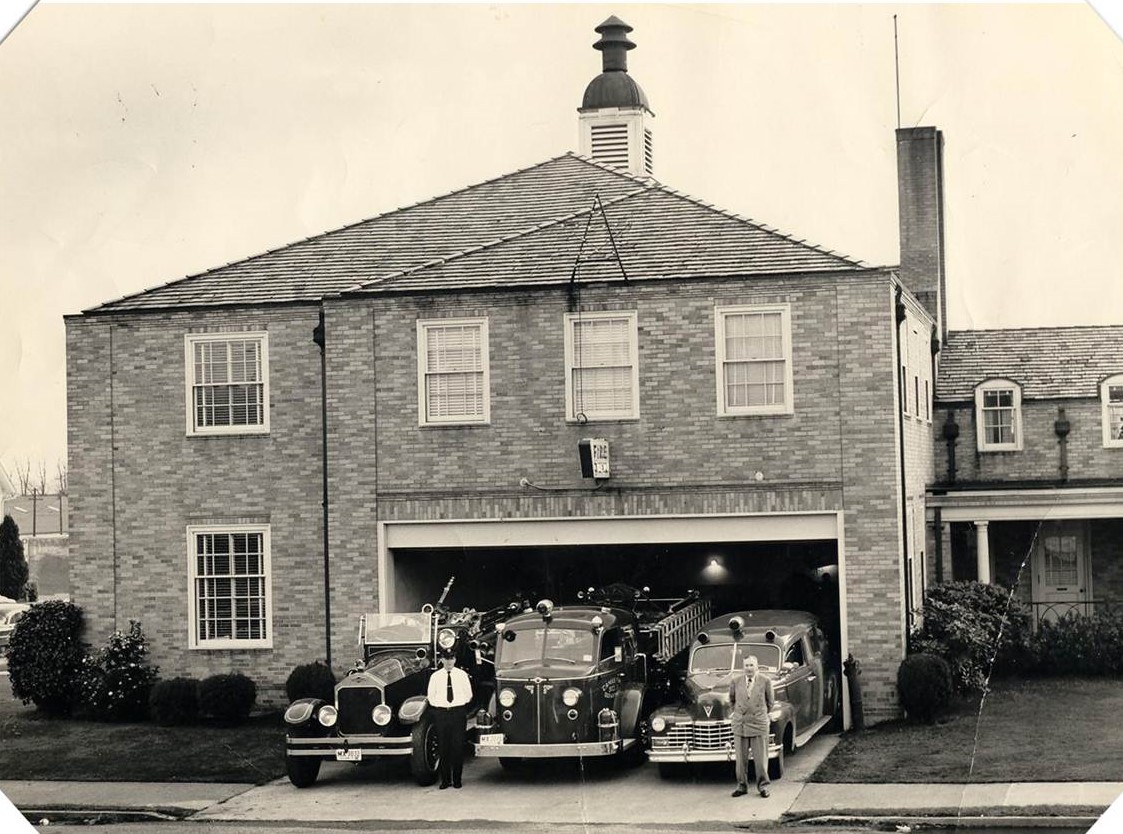
Fire trucks in the old fire department where the library is now
Thank you for going on the Downtown Camas Historic Walking Tour!
This is just a smattering of the incredible history of Downtown Camas! We hope you enjoyed the tour and your visit in our downtown. Hope to see you again soon!
If you want to find a few more artful treasures in downtown, look for Millie the Bronze Dog (also made by artist Georgia Gerber) by the Liberty Theatre, the 8 artful bike racks in town made by mill craftsman Tony Markowski–each with a different regional art motif, the Camas Love Mural near 5th & Cedar painted by student Hailee Parman and the quaint coffee garden painted by local artist Jenn Mansur by Caffe Piccolo on 4th & Cedar. Click here for a Mural Tour map to find more. We love that local art is part of our Camas history!
This tour was written and brought to you by the Downtown Camas Association.
